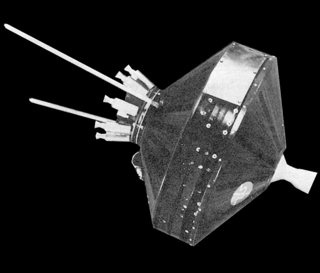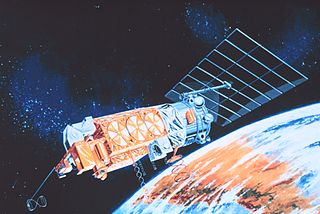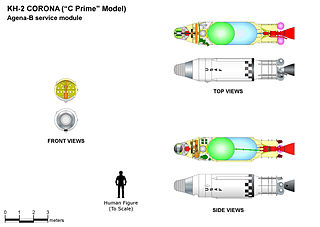
Pioneer 1 was an American space probe, the first under the auspices of NASA, which was launched by a Thor-Able rocket on 11 October 1958. It was intended to orbit the Moon and make scientific measurements, but due to a guidance error failed to achieve lunar orbit and was ultimately destroyed upon reentering Earth's atmosphere. The flight, which lasted 43 hours and reached an apogee of 113,800 km, was the second and most successful of the three Thor-Able space probes.
Kosmos 60 was an E-6 No.9 probe, launched by the Soviet Union. It was the sixth attempt at a lunar soft-landing mission, with a design similar to that of Luna 4.

NOAA-7, known as NOAA-C before launch, was an American operational weather satellite for use in the National Operational Environmental Satellite System (NOESS) and for the support of the Global Atmospheric Research Program (GARP) during 1978-1984. The satellite design provided an economical and stable Sun-synchronous platform for advanced operational instruments to measure the atmosphere of Earth, its surface and cloud cover, and the near-space environment. An earlier launch, NOAA-B, was scheduled to become NOAA-7, however NOAA-B failed to reach its required orbit.
Kosmos 70, also known as DS-A1 No.7 was a technology demonstration satellite which was launched by the Soviet Union in 1965 as part of the Dnepropetrovsk Sputnik programme. Its primary mission was to demonstrate technologies for future Soviet military satellites. It also conducted radiation experiments.
Kosmos 25, also known as DS-P1 No.4 was a prototype radar target satellite for anti-ballistic missile tests, which was launched by the Soviet Union in 1964 as part of the Dnepropetrovsk Sputnik programme. Its primary mission was to demonstrate the necessary technologies for radar tracking of spacecraft, which would allow future satellites to function as targets.
Kosmos 26, also known as DS-MG No.1 was a scientific satellite which was launched by the Soviet Union in 1964. This mission studied the Earth's magnetic field and, along with Kosmos 49, represented the USSR contribution to the International Quiet Solar Year World Magnetic Survey. The corresponding American measurements were performed by the satellites OGO 2 and OGO 4.
Kosmos 49, also known as DS-MG No.2 was a scientific satellite which was launched by the Soviet Union in 1964. This mission used proton magnetometers to map the Earth's magnetic field and, along with Kosmos 26, represented the USSR's contribution to the International Quiet Solar Year World Magnetic Survey. The corresponding American measurements were performed by the satellites OGO 2 and OGO 4. It also conducted scientific research into the Earth's infrared flux and ultraviolet flux.
Kosmos 101, also known as DS-P1-Yu No.4 was a Soviet satellite which was used as a radar calibration target for tests of anti-ballistic missiles. It was built by the Yuzhnoye Design Bureau, and launched in 1965 as part of the Dnepropetrovsk Sputnik programme.
Kosmos 23, also known as Omega No.2, was a satellite which was launched by the Soviet Union in 1963. It was an Omega satellite, derived from the Dnepropetrovsk Sputnik series. It was a 347 kilograms (765 lb) spacecraft, which was built by the Yuzhnoye Design Office, and was used to conduct experiments with the use of gyroscopes to control spacecraft, for VNIIEM.

Discoverer 18, also known as Corona 9013, was an American optical reconnaissance satellite launched on 7 December 1960 at 20:24:00 GMT. It was the first successful, and the third of ten total Corona KH-2 satellites, based on the Agena-B.
Kosmos 37 or Zenit-2 No.22 was a Soviet, first generation, low resolution, optical film-return reconnaissance satellite launched in 1964. A Zenit-2 spacecraft, Kosmos 37 was the twentieth of eighty-one such satellites to be launched and had a mass of 4,730 kilograms (10,430 lb).
Kosmos 46 or Zenit-2 No.23 was a Soviet, first generation, low resolution, optical film-return reconnaissance satellite launched in 1964. A Zenit-2 spacecraft, Kosmos 46 was the twenty-second of eighty one such satellites to be launched and had a mass of 4,730 kilograms (10,430 lb).
Kosmos 48 or Zenit-2 No.24 was a Soviet, first generation, low resolution, optical film-return reconnaissance satellite launched in 1964. A Zenit-2 spacecraft, Kosmos 48 was the twenty-third of eighty-one such satellites to be launched and had a mass of 4,730 kilograms (10,430 lb).
Kosmos 64 or Zenit-2 No.17 was a Soviet, first generation, low resolution, optical film-return reconnaissance satellite launched in 1965. A Zenit-2 satellite, Kosmos 64 was the twenty-sixth of eighty-one such spacecraft to be launched and had a mass of 4,720 kilograms (10,410 lb).
Kosmos 68 or Zenit-2 No.29 was a Soviet, first generation, low resolution, optical film-return reconnaissance satellite launched in 1965. A Zenit-2 spacecraft, Kosmos 68 was the twenty-eighth of eighty-one such satellites to be launched and had a mass of 4,730 kilograms (10,430 lb).
Kosmos 78 or Zenit-2 No.30 was a Soviet, first generation, low resolution, optical film-return reconnaissance satellite launched in 1965. A Zenit-2 spacecraft, Kosmos 78 was the thirtieth of eighty-one such satellites to be launched and had a mass of 4,730 kilograms (10,430 lb).
Kosmos 98 or Zenit-2 No.31 was a Soviet, first generation, low resolution, optical film-return reconnaissance satellite launched in 1965. A Zenit-2 spacecraft, Kosmos 98 was the thirty-first of eighty-one such satellites to be launched and had a mass of 4,730 kilograms (10,430 lb).
Kosmos 104 or Zenit-2 No.36 was a Soviet, first generation, low resolution, optical film-return reconnaissance satellite launched in 1966. A Zenit-2 spacecraft, Kosmos 104 was the thirty-second of eighty-one such satellites to be launched and had a mass of 4,730 kilograms (10,430 lb).
Kosmos 107 or Zenit-2 No.34 was a Soviet, first generation, low resolution, optical film-return reconnaissance satellite launched in 1966. A Zenit-2 spacecraft, Kosmos 107 was the thirty-fifth of eighty-one such satellites to be launched and had a mass of 4,730 kilograms (10,430 lb).
Kosmos 57 was an unmanned Soviet spacecraft launched on 22 February 1965. The craft was essentially an unmanned version of Voskhod 2. Its primary mission was to test the Volga airlock. The test was successful, but the craft was lost shortly after. The spaceflight is designated under the Kosmos system, placing it with many other Soviet scientific and military satellites.


